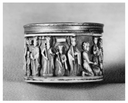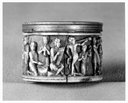Description
Sixteen figures encircle this pyxis, beginning with a kneeling figure offering a city--rendered in the medieval manner of a miniature castle--to an emperor. A peacock sits below the "city." The emperor is the first imperial figure of two groups, each consisting of a long-bearded emperor and an empress flanking a youth. These frontally posed court figures are followed by musicians, including a drummer, flutist, harpist, two trumpeters, a lute player, and a syrinx (?) player, and two dancers, one with arms akimbo and the other with a scarf behind her head. This last performer is half-hidden behind the first, kneeling figure.
Deeply carved, the pyxis has a very thin wall that has broken in two places, creating two halves, held together by a metal ring at the top. The lid is slightly domed and is engraved with concentric circles; twenty-four smaller circles, twenty of which retain their gilt-wax insets, fill the space between two of these larger circles
The interpretation of the figural scene is based on N. Oikonomides (1977): the emperor John VII Palaiologos (r. 1403-8) receives the city of Thessalonike, accompanied by his wife, Irene, and son Andronikos. John's co-emperor is his uncle Manuel II (r. 1391-1425). Though the rulers had been at times estranged, they reached an agreement in 1403: Manuel would rule from Constantinople and John from Thessaloinike as "emperor of all Thessaly." Thessalonike had just been returned to Byzantium by the Turks, and Constantinople to Manuel by Johm, who had served as regent during Manuel's four-year absence in Europe--the elder emperor had tried to raise funds for the defense of the empire against the Turks. The inclusion of their sons crowned as emperors alludes to a policy of alternating dynastic succession that had also been worked out.
The celebratory imagery on the pyxis represents the optimistic scheme for power-sharing between John VII and Manuel II, w hich seems to have been an attempt to settle the ambitions of nephew and uncle as well as to offset the vulnerability of the Byzantine Empire in the face of Turkish expansion. The carver has shown the formality of the new imperial order and the musical performance that would have accompanied its establishment.
J. Hanson
Bibliography
J. Strzygowski, "Anfrage," Byzantinische Zeitschrift 7 (1899), esp. 262.
Exposition internationale d'art Byzantin, exhibition catalogue, Musée des Arts Décoratifs, Palais du Louvre, 28 May-9 July, 1931, (Paris, 1931), 84, no. 141.
A. Grabar, L'empereur dans l'art byzantin: recherches sur l'art officiel de l'empire d'Orient, Publications de la Faculté des lettres de l'Université de Strasbourg 75 (Paris, 1936, repr. 1971), 55-57, 155, pl. 8.
F. Dölger, "Review of Grabar," Gnomon 14 (April 1938), esp. 208.
Arts of the Middle Ages; a Loan Exhibition, exhibition catalogue, Museum of Fine Arts Boston, February 17 to March 24, 1940, (Boston, 1940), 41, no. 122, pl. 5.
The Dumbarton Oaks Research Library and Collection of Harvard University, Handbook of the Collection (Washington, D.C., 1946), 79, no. 163, fig. p. 89.
The Dumbarton Oaks Collection, Harvard University (Washington, D.C., 1955), 108, no. 241.
A. Grabar, "Une pyxide en ivoire à Dumbarton Oaks: Quelques notes sur l'art profane pendant les derniers siècles de l'Empire byzantin," Dumbarton Oaks Papers 14 (1960): 121-46.
Handbook of the Byzantine Collection (Washington, D.C., 1967), 83, no. 291.
G. C. Dunning, A Medieval Jug Found in London, Decorated with Human and Animal Figures (Paris, 1971), 11-12, pl. II, fig. 1,2.
K. Weitzmann, Ivories and Steatites, Catalogue of the Byzantine and Early Mediaeval Antiquities in the Dumbarton Oaks Collection 3 (Washington, D.C., 1972), 77-82, no. 31, pl. 52, 53.
N. Oikonomides, "John VII Palaeologus and the Ivory Pyxis at Dumbarton Oaks," Dumbarton Oaks Papers, No. 31 (1977), 329-337.
A. Cutler, The Craft of Ivory: Sources, Techniques, and Uses in the Mediterranean World: A.D. 200-1400 (Washington, D.C., 1985), 16, figs. 19, 32, 33.
A. Cutler, The Hand of the Master: Craftsmanship, Ivory, and Society in Byzantium (9th-11th Cent.) (Princeton, NJ, 1994), 284, n. 121.
A. Cutler, "From Loot to Scholarship: Changing Modes in the Italian Response to Byzantine Artifacts, ca. 1250-1750," Dumbarton Oaks Papers, No. 49 (1995), p. 255.
I. Kalavezou, Byzantine Women and Their World (Cambridge, MA, 2003), 142, fig. 14.
H. Evans, ed., Byzantium: Faith and Power (1261-1557) (New York, NY, 2004), 30-31, no. 5.
G. Bühl, ed., Dumbarton Oaks: The Collections (Washington, D.C., 2008), 182, pl. p. 183.
A. Akisik, "Praising A City: Nicaea, Trebizond, and Thessalonike," Journal of Turkish Studies (2011): 1-25, esp. 33.
G. Currie, "Depictions of Musical Instruments in Byzantine and Post-Byzantine Iconography," in Hellenika Mousika Organa: Anazeteseis se Eikastikes kai Grammateiakes Martyries (2000 p.Ch. - 2000 m.Ch.) ed. A. Goulaki-Voutyra 2012), 271, esp. 141, fig. X.21a-b. (Mistakenly given the accession number 36.26 in text.)
A. Lymberopoulou and R. Duits, eds., Byzantine Art and Renaissance Europe (Farnham, Surrey, England, 2013), 25, fig. 1.6.
R. J. Macrides, J. A. Munitiz, and D. Angelov, Pseudo-Kodinos and the Constantinopolitan Court: Offices and Ceremonies, Birmingham Byzantine and Ottoman Studies (Farnham, Surrey, UK; Burlington, VT, 2013), pl. 15.
G. Currie, "Glorious Noise of Empire," in Medieval and Early Modern Performance in the Eastern Mediterranean 20, ed. A. Öztürkmen and E.B. Vitz (Turnhout, Belgium, 2014), esp. 439, fig. 26.3.
C. J. Hilsdale, Byzantine Art and Diplomacy in an Age of Decline (Cambridge, 2014), 211, fig. 4.0a-b.
Exhibition History
Paris, Musée des arts décoratifs, "Exposition internationale d'art byzantin, " May 28 - July 9, 1931.
Boston, Museum of Fine Arts, "Arts of the Middle Ages," Feb. 17 - Mar. 24, 1940.
Cambridge, Mass., Fogg Art Museum, "A Selection of Ivories, Bronzes, Metalwork and Other Objects from the Dumbarton Oaks Collection," Nov. 15 - Dec. 31, 1945.
Washington, D.C., Dumbarton Oaks, "The Craft of Ivory," Oct. 22, 1985 - Jan. 6. 1986.
New York, The Metropolitan Museum of Art, "Byzantium: Faith and Power (1261-1557)," March 23 - July 4, 2004.










